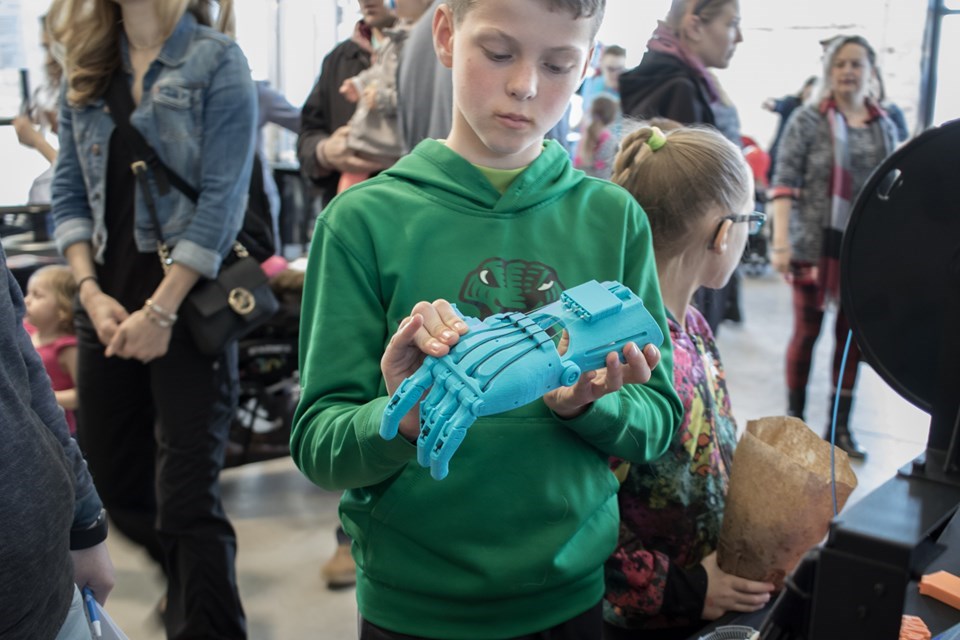Broke the tip off your vacuum? Can’t find that random little plastic knob for your vintage snowmobile? Maybe you need a prosthetic limb?
Just send this new Sault Ste. Marie business a computer file and they’ll be able to help you print just about anything you can imagine — and they have big plans to grow.
Local 3-D printing based business Maker North Inc. made its public debut at the Sault Ste. Marie Science Festival on April 29.
The startup company — which incorporated just two months ago — was out promoting their ‘all things maker’ service with a heavy focus on 3-D printed objects.
On display were 3-D printed gadgets, models, toys, a gaming console, and even hand prosthetics that can actually grip things.
Maker North co-owner Mike Sacchetta said the business can potentially replace a $90,000 upper arm prosthetic with a 3-D printed one using less than $20 in materials.
Right now Maker North is based out of the 1,000-square-foot home shop of the other co-owner, Joe Bertrand, but in the next six to 12 months they would like open a physical ‘makerspace’ location somewhere in the city.
The makerspace is planned to be open to the public with gym-like, different-tiered monthly memberships which give members access to 3-D printers and other creative tools like electronics kits, 3-D scanning, a laser cutter, and more.
Maker North does most of its printing with PLA (polylactic acid) filament – typically, colourful biodegradable plastic material derived from plants like corn or sugarcane.
Most individuals and businesses that 3-D print order the filament in long spools; however, in the coming months Maker North is going to be creating and spooling the material themselves from imported raw pellets.
If everything goes according to the company's five-year plan, Maker North will work with local farmers to source some kind of plant material — even farm plant-waste — to produce their own PLA pellets in the Sault.
Maker North predicts filament sales will eventually be its largest source of revenue.
They plan to combine different colours for marble-like effects, and combine PLA with rubber and even wood filings to make very unique material to 3-D print with.
“Hopefully (Maker North) will be able to cut down the cost of everything. We’re going to be able to offer filament cheaper than Amazon.ca,” said Sacchetto.
For now, however, the business is focusing on simply printing objects for people.
Due to copyright issues, for the most part Maker North is simply taking user-submitted designs to print, although they are able to make some designs themselves on request.
Sacchetta said most people find designs with open source licenses freely online at sites like Thingiverse.com.
Customers simply have to download or create a stereolithography file (.stl fie), send it to Maker North, and they will print it.
Maker North also has scanning tools to help people copy items; for example, one-of-a-kind objects or antique items.
Sacchetta said stories of 3-D printed guns in the media have created controversy around the technology — he had at least one person come up to him with concerns at the Science Carnival.
“People don’t realize that if you make a firearm out of anything, the RCMP laws are the same. You can’t just hit ‘gun print’ on a computer,” Sacchetta said. “People that have actually done it have metal barrels and metal firing pins; they can’t just use a 3D printer.”
“We have this great technology where you can do almost anything but is this sort of controversy going to be its downfall? Miseducated people are just spreading rumors and it might mean the government puts laws on these things.”
Sacchetta said that he sees part of the threat to 3-D printers is coming from corporations that make money off selling tiny plastic parts for high prices.
If a car’s air conditioner knob breaks, for example, people can now potentially make it for just a few dollars instead of anything from $60 to $200, said Sacchetta.
Another potential use for the technology is for visual artists who create drawings or designs on their home computer but don’t have the means to print.




